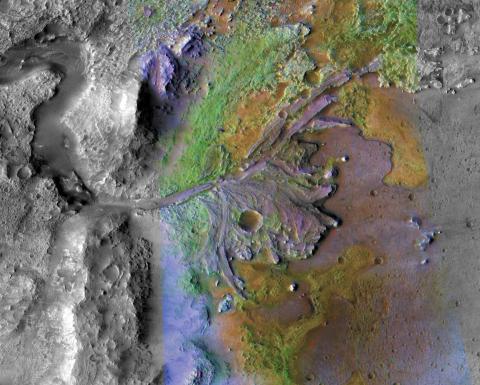Scientists have long known that water was abundant on ancient Mars, but there has been no consensus on whether liquid water was common, or whether it was largely frozen in ice. Was the temperature high enough to allow the water to flow? Did this happen over an extended period, or just occasionally? Was the surface a desert or frozen? Warm conditions make it much more likely that life would have developed independently on the surface of ancient Mars.
A new comparison of patterns of mineral deposition on the red planet with similar depositions on Earth lends weight to the idea that early Mars had one or more long periods dominated by rainstorms and flowing water, with the water later freezing.

Jezero Crater Delta, the site of the Mars2020 landing. Image: NASA/JPL-Caltech/MSSS/JHU-APL
Analysis of the surface geology of Mars supports a trend from a warm to a cold climate, but older climate computer models don't support this, due to the limited heat arriving from the young Sun.
Here on Earth, we find silica deposition in glaciers which are characteristic of melting water. On Mars, technology can identify similar silica deposits in younger areas, but also older areas which are similar to deep soils from warm climates on Earth. This leads some to believe that on Mars 3 to 4 billion years ago, there was a general slow trend from warm to cold, with periods of thawing and freezing.
The building blocks of life on Earth developed very soon after the Earth's formation, and flowing water was essential for life's development. Evidence of early, flowing water on Mars will increase the chances that simple life may have developed at around the same time as it did on Earth.
The Mars 2020 mission will be able to look more closely at these minerals, and begin to answer exactly what conditions existed when Mars was still young.
So for now, the research team compared Earth data to Martian minerals detected using the NASA CRISM spectrometer, currently orbiting Mars, which can remotely identify surface chemicals where water once existed. They also took data from the Mars Curiosity Rover. The Mars 2020 mission is due to be launched in July 2020 and will explore the Jezero Crater in February 2021.
Presenting the findings today at the Goldschmidt Geochemistry Conference in Barcelona, Professor Briony Horgan (Purdue University) said, "We know there were periods when the surface of Mars was frozen; we know there were periods when water flowed freely. But we don't know exactly when these periods were, and how long they lasted. We have never sent unmanned missions to areas of Mars which can show us these earliest rocks, so we need to use Earth-bound science to understand the geochemistry of what may have happened there. Our study of weathering in radically different climate conditions such as the Oregon Cascades, Hawaii, Iceland, and other places on Earth, can show us how climate affects pattern of mineral deposition, like we see on Mars."





Comments